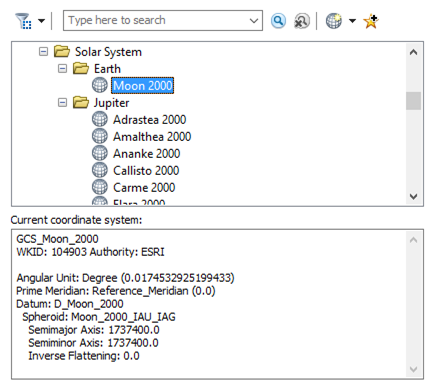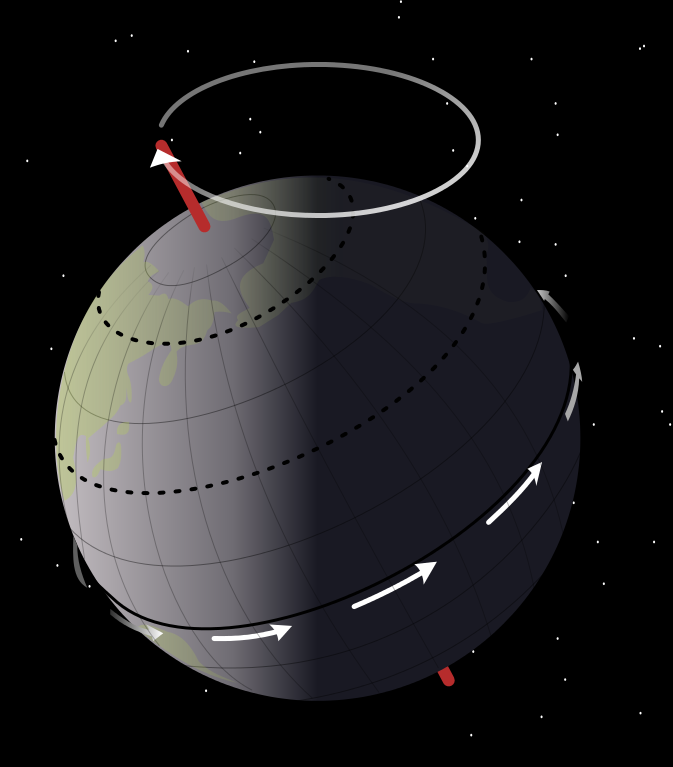- Home
- :
- All Communities
- :
- User Groups
- :
- Coordinate Reference Systems
- :
- Blog
- :
- Drifting of the celestial sphere: What is J2000?
Drifting of the celestial sphere: What is J2000?
- Subscribe to RSS Feed
- Mark as New
- Mark as Read
- Bookmark
- Subscribe
- Printer Friendly Page
What does the "2000" mean at the end of the coordinate system names in the Solar System folder?

You can also find reference to the number in the details of the *.prj file itself.
GEOGCS["GCS_Jupiter_2000",DATUM["D_Jupiter_2000",
SPHEROID["Jupiter_2000_IAU_IAG",
71492000.0,15.41440275981026]],
PRIMEM["Reference_Meridian",0.0],
UNIT["Degree",0.0174532925199433]]The number suffix is, in fact, a date. It refers to the currently used standard equinox (and epoch) which is J2000.0.
The prefix "J" indicates that it is a Julian epoch and the number refers to January 1, 2000, 12:00 Terrestrial Time. There have been other standard equinoxes (and epoch) where the previous version was B1950.0, with the prefix "B" indicating it was a Besselian epoch. Julian equinoxes and epochs have been used for every equinox since 1984.
Why do we need to use a fixed date and time?
In a phrase, J2000 is needed due to the precession of the equinoxes.
Forming part of the Milankovitch theory of long term climate change the precession of the equinoxes refers to the observable phenomena of the rotation of the celestial sphere. A cycle which spans a period of (approximately) 25,920 years, over which time the constellations appear to slowly rotate around the earth, taking turns at rising behind the rising sun on the vernal equinox.
 Precessional movement of Earth (right). Earth rotates (white arrows) once a day around its rotational axis (red); this axis itself rotates slowly (white circle), completing a rotation in approximately 26,000 years
Precessional movement of Earth (right). Earth rotates (white arrows) once a day around its rotational axis (red); this axis itself rotates slowly (white circle), completing a rotation in approximately 26,000 years
Watch this video on Precession of the Earth
What are the effects of the Precession of Equinoxes on reference systems?
If the position of the celestial poles and equators are changing on the celestial sphere, then the celestial coordinates of objects, which are defined by the reference of the celestial equator and celestial poles, are also constantly changing and since the location of the equinox changes with time, coordinate systems that are defined by the vernal equinox must have a date associated with them.
This specified year is called the Equinox (not epoch). Currently, we use Equinox J2000.0
The main epochs in common use are:
– B1950.0 - the equinox and mean equator of 1949 Dec 31st 22:09 UT.
– J2000.0 - the equinox and mean equator of 2000 Jan 1st 12:00 UT
The B1950 and J2000 reference frames are defined by the mean orientation of the Earth’s equator and ecliptic at the beginning of the years 1950 and 2000.
You must be a registered user to add a comment. If you've already registered, sign in. Otherwise, register and sign in.